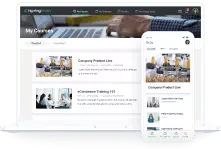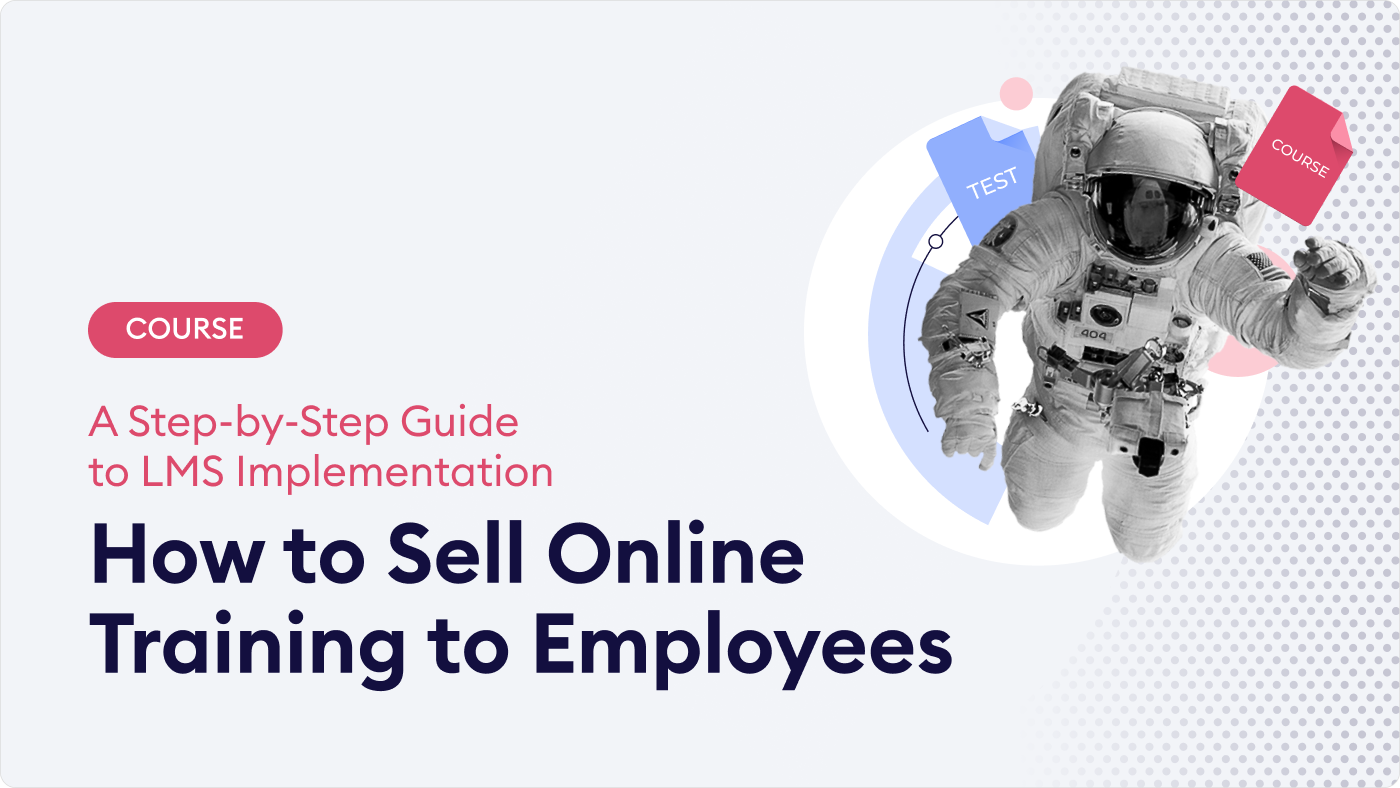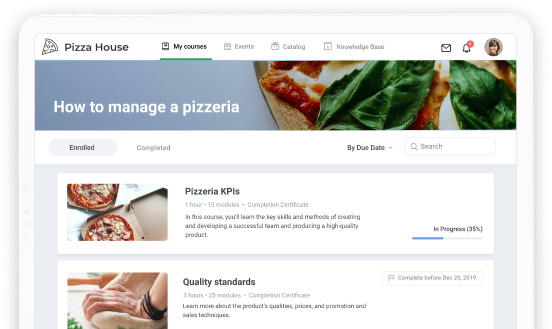How to Light a Fire in the Sales Newbie’s Eyes — iSpring’s Case
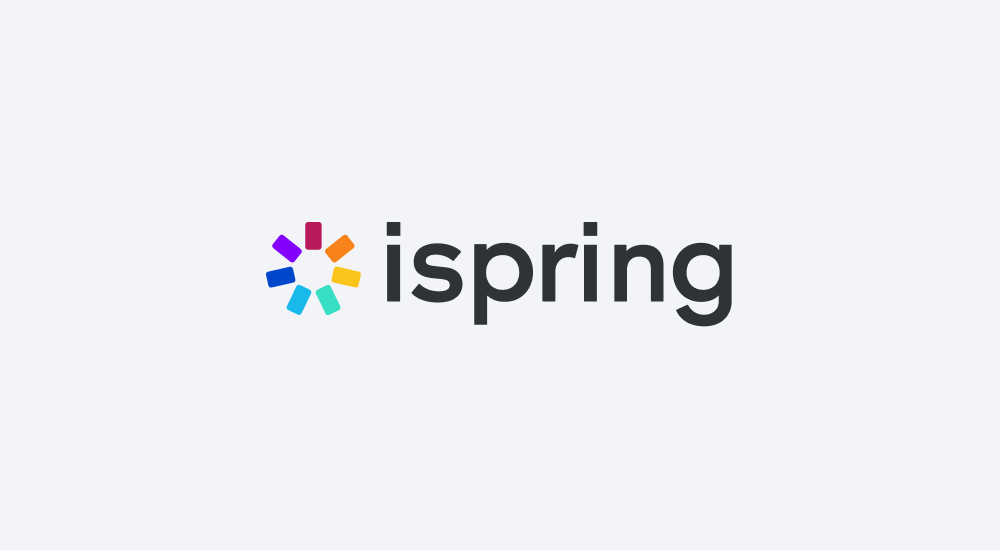
Imagine walking into a new shop that has a number of interesting things, but no one meets you or offers any help. You soon lose interest, as well as any desire to buy something. Will you stay there for a long time? Will you come again? The same happens with newbies in a new job.
It’s no longer necessary to prove the importance of quality onboarding. It has evolved from a pleasant formality to a strategy that companies need to get right.
Few people come to a new job fully prepared, especially salespeople. Companies promote their products in different ways and follow various sales approaches, so even the most experienced salespeople need to adapt to the new environment to better apply their skills and meet quotas. What’s more, your sales team is a customer-facing team — they build relationships with leads and close deals. That’s why the cost of uncertainty in sales techniques or a misunderstanding of product values can be enormous.
To let newcomers succeed, you need to create an effective onboarding program that will introduce the company’s strategy and provide all the knowledge they need to perform their job well. But how can you get it all right?
In this article, Tiana Ray, Sales L&D Manager at iSpring Solutions, shares how their team changed their approach to sales onboarding and made it faster and more efficient. We’ll be gratified if our experience helps streamline sales onboarding in your company.
Here’s a brief summary of the challenges we faced, how we overcame them, and what we achieved.

Tiana Ray, Sales L&D Manager at iSpring
iSpring Sales Team Onboarding: How We Used To Do It
In 2021, iSpring had 80 salespeople. The company didn’t have a systematic onboarding program for sales newbies. It also didn’t have a separate team to develop such a training program. Instead, iSpring provided a general onboarding program with plenty of different materials that weren’t framed into one straight learning path. They were tough to navigate, so we faced low completion rates.
As a result, this onboarding program was not conducive to growing the sales team as expected. Most newbies didn’t know the fundamentals of sales. They:
- Confused sales stages. Newcomers were uncertain about the kind of lead they were dealing with and what kinds of questions they should ask. They also didn’t understand what was important for different types of decision-makers.
- Presented features, not values. New salespeople couldn’t communicate the value of our product to the customer clearly or tell what a specific customer’s problem it could solve.
- Didn’t plan or set goals. New hires didn’t set a final goal for a call before they dialed. They also lacked time management skills.
Since our sales newbies had so many knowledge gaps, they couldn’t perform their job well and often took up too much of their colleagues’ time, which worsened the results of the entire team.
Actually, these gaps were the results of the onboarding program that existed at that time, and we needed to fill them. Here’s how we did it.
Our Sales Onboarding Now
iSpring had good onboarding courses, but as it turned out, they were poorly organized. The learning content was scattered: sales training was conducted through a learning management system, and some of the instructions were sent to newbies via email.
We needed to streamline product and sales training, so we introduced these four major changes to the sales onboarding program:
1. A well-structured onboarding program in iSpring Learn
Previously, new hires weren’t 100% involved in the training. They skipped tasks and didn’t understand the sequence of onboarding steps clearly. Now, all the materials and courses are implemented in a learning management system (LMS), iSpring Learn. We combined both sales and product training into a single comprehensive learning track.
We divided the content into weeks and days to make the structure clear and simple for newcomers to follow. Now, they always know what to do and don’t distract top sales performers from their primary tasks.
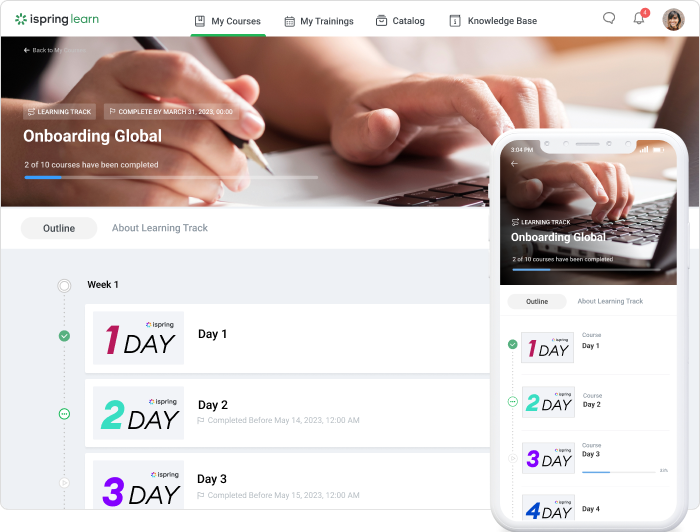
Since all the content is stored in a single LMS, it becomes extremely easy to track the newbies’ progress. Sales skills are tested through value-oriented assignments by the Sales Quality and Learning (Q&L) team. Product knowledge assessments are checked by our tech support team.
When you put all the content together in a single onboarding learning pathway, it’s easy to track the learner’s progress and spot difficulties in time.
PL3h507uK1S2nR7Tyi0oGiCW12C8xxw-YC
All the courses within the path are available at once, so the learner can perform the next one while the previous assignment is waiting to be checked. At the end, the learners’ progress is viewed in perfect detail, thanks to numerous reports.
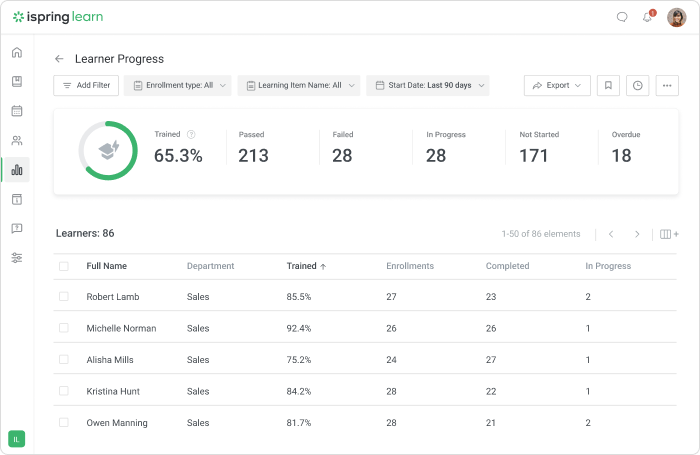
2. Interactive courses created with iSpring Suite
iSpring’s sales onboarding program includes different types of content. We use the iSpring Suite authoring toolkit effectively to create video lectures, interactive role-plays, and multiple quizzes. Adding audio, video, and interactivity to our onboarding courses makes them more captivating and helps newbies retain new information better. Below you can see one of the courses created in iSpring Suite.
We separated the two fronts of work. We now assign two buddies to each newbie. One is from the sales team — they explain our company mission and vision and give newcomers advice when needed. The second buddy is an iSpring tech geek who helps them master the company’s products and understand how they work. Both product and sales buddies make onboarding less stressful and more enjoyable.
The buddy system has become an integral part of onboarding in all departments at iSpring.
3. Blended learning
Sales onboarding combines eLearning with face-to-face meetings and calls that can be easily scheduled on the iSpring Learn calendar. During meetings with buddies and staff from the Sales L&D department, the newbies learn to conduct conversations with the client. They master sales skills in a safe-to-fail environment and don’t risk blowing the deal.
During onboarding, new hires also attend Q&L meetings, where they learn more about different sales techniques and broaden their knowledge.
4. Collaboration
The involvement of different departments contributes to teamwork and shared responsibility for the outcome. Now, everyone involved in the onboarding process has their own areas of responsibility. Tech support helps newbies master the company’s products while the Sales L&D department controls sales training. Sales buddies also request all the necessary access for newbies from the IT department and share their knowledge and tricks, such as how to better plan their working day and many others.
Collaboration between departments helps speed up the process significantly. Thanks to the division of responsibility, no one is overly distracted from their primary tasks, and the newcomer always knows who to turn to with questions that come up.
What Have We Achieved So Far
Our onboarding program is now completely different from what we had before. We moved away from haphazard courses that are difficult to take. Instead, we’ve combined all the learning materials into one compound learning path.
Now at iSpring, there are 150 sales reps all over the globe in 24 time zones. Most of them work remotely. And we hire 4-6 new salespeople every quarter.
Our new onboarding program has already been successfully completed by 40 newbies. We’re still in the process of establishing effective onboarding, but we’ve already achieved significant outcomes.
A comfortable pace
Our onboarding program takes 90 days to complete. The first week is devoted to sales basics: who a seller is, what a typical sales cycle looks like, what the sales stages are, and a lot of other important theory. The second week is about products and iSpring sales methodology training. Half a day is for sales and the other half is for products.
We’re not after speed, we’re after results. And that’s why those who haven’t completed all sales assignments or haven’t fully mastered the product are not allowed to make calls.
We’re dealing with people. If the learners need more time, we give them more time, because everyone’s different.
Rapid transition to full productivity
Confused newcomers with technical gaps and underdeveloped skills are things of the past. We have faith in our newbies and aren’t afraid to delegate customer negotiations to them. Previously, new salespeople started to call customers and prospects only after the second month. Now trial calls start in the third week of the first month.
Transparent onboarding with clear job expectations
Thanks to the straight onboarding learning path, the division of responsibility between different departments, and the buddy system, all that is required from a newbie is to be ready to absorb new information.
After 90 days, we get salespeople who clearly understand the company’s mission and vision, its strategic goals, and how the sales team is personally involved in achieving them. They know clients’ pains, our products, and how to deliver their benefits to the customers.
Key Takeaways
We’re glad to share our insights and hope they’ll help you avoid a number of mistakes when planning onboarding at your company. These tips are useful not only for onboarding newly hired salespeople but will also come in handy for other departments.
- Establish a separate Learning and Development (L&D) function inside your sales team. At first glance, HR and L&D may seem the same: they both deal with onboarding and training. But if HR gets involved on request — for example, when a problem arises — then L&D provides a long-term, ever-evolving process that aims to align employees’ skills and knowledge with the company’s objectives.
If your sales onboarding is only an introduction to tools and doesn’t plan for long-term learning, then your efforts will most likely be in vain. So, if you want to scale up your business, you should consider establishing a Sales Learning and Development department.
L&D takes a proactive approach to increasing employee satisfaction, with a focus on providing tools for them to learn.
Also read:
The 11 Best HR Tools for Streamlining Your Workflow in 2023
Mentorship Program: All You Should to Know in 2023 [Expert Insights]
- Make a clear onboarding path. It’s not enough to create an onboarding program and assume that it will work. It’s important to make sure it’s logical, easy to navigate, and provides all the information the newbies need. By carefully planning onboarding steps, you can give new employees all the tools and knowledge they need to be successful at their job. A clear onboarding structure helps newcomers realize their job functions and expectations, especially if they work remotely.
- Ensure collaboration between departments. Fast onboarding is the result of collaboration between different departments. Don’t be afraid to involve many people in the onboarding process. We value the technical support staff who provide product training, as well as our IT department, which quickly assists newcomers with all of the various accesses and software that our salespeople use. When we got the IT, HR, L&D departments, and tech support involved in onboarding, we created a powerful symbiosis.
- Implement a buddy system. If you still don’t have a buddy system, maybe now is a good time to think about it. Having an ‘older brother or sister,’ even via Zoom, is helpful. Buddies will provide the company’s mission and values, and help onboard the newbies faster. They also help you ensure that new employees are ready to step into their job responsibilities.
- Collect feedback. Building a new onboarding system without collecting feedback is a mistake. Find out how the entire process is going for everyone, including new hires, hiring managers, mentors, and coworkers, to get ideas for improvement.
Final Thoughts
It may seem obvious, but how well you onboard your sales team will determine their performance and, ultimately, your company’s success.
When you’re creating an onboarding program, think about the people and how you can affect them.
The best part about onboarding is that, by hiring a new employee, you’re entering a whole new world. A newbie comes into the company, and it’s up to you as to whether they leave after three months or grow into top professionals and stay with you for many years.
